Expert Foot & Ankle Treatment from Michigan’s #1 Podiatrist - Balance Foot & Ankle Specialist
Diabetic Foot Ulcer Treatment
Causes, Symptoms & Best Supplies
Diabetic foot ulcer treatment is best treated by a podiatrist and foot specialist 95%. Don’t put your leg at risk, get your leg healed immediately and seeing a podiatrist as fast as you can!
What a Podiatrist Can Do For YOU!
Podiatrist Diabetes Ulcer Treatment
Podiatrist & Foot Doctor Diabetes Foot Ulcer Treatment:
Do you have Diabetic foot pain? This may be the start of a Diabetic Foot Ulcer. We go over the Diabetic Foot Ulcer Early Signs, Causes & BEST Home Treatments
How to treat a diabetic foot ulcer:
0:00 What is a diabetic foot ulcer?
0:53 Diabetic foot ulcer causes
1:08 Diabetic foot ulcer beginnings
2:55 Diabetic foot ulcer infection treatment
3:17 Diabetic foot ulcer stages
3:47 Diabetic foot ulcer podiatrist and diabetic foot ulcer doctors
4:27 Diabetic foot ulcer early signs
4:44 Infected diabetic foot ulcer treatment
5:10 Diabetic foot ulcer treatment at home
5:45 Diabetic foot ulcer total contact cast
6:30 Diabetic foot ulcer shoes
6:45 Diabetic foot ulcer orthotics
7:20 Diabetic foot ulcer exercises and Diabetic foot ulcer stretches
9:08 Early stage diabetic foot ulcer
9:53 Diabetic foot ulcer Home Treatment
10:10 Diabetic foot ulcer Peripheral Neuropathy
What is a diabetic foot ulcer?
- A diabetic foot ulcer is a sore on the bottom of your foot that occurs at some point in almost 25% of all diabetic patients throughout their life.
- The most common site for a diabetic ulcer is on your foot.
- Many of these people become hospitalized due to an infection or an ulcer, or related complications.
- Diabetes and blood flow disease has been called the number one cause of foot or leg amputation in the United States.
- Some patients who develop a full ulcer, if untreated, can progress to amputation. Those people with diabetes who do receive amputation are almost always preceded by diabetic foot ulceration.
- Research has shown that working with a podiatrist is one of the single best things to prevent your foot.
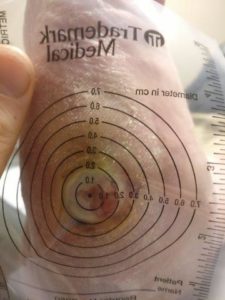
Causes of a Diabetic Foot Ulcer:
- if you have diabetes, there is a strong chance that you can sometimes develop a foot ulcer throughout your life if you do not take the right precautions.
- Studies do show that certain populations and backgrounds are more likely to develop an ulcer. The single most common demographic is older men. This includes Native Americans, Hispanic, and African-American populations.
- Patients who are advanced diabetics who need to use insulin are at the highest risk of developing a full ulcer. This is especially true if you have diabetes-related issues such as kidney, eye, and heart disease.
- A diabetic foot ulcer is also strongly correlated to both being overweight and using alcohol.
- The two biggest associated health conditions to being a diabetic are smoking and the use of alcohol.
- Diabetic foot ulcers almost always start diabetic foot infections
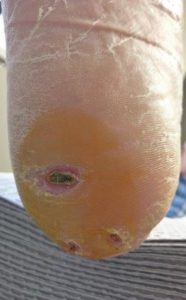
Hard skin can develop in pressure areas of the foot. This can lead to an ulcer with cracks and fissures.
Diabetic Foot Care Prevention
- Most Diabetic foot ulcers are formed due to a combination of numerous factors: the most common of these is the lack of feeling in your foot, poor blood flow down to your foot, foot deformities, constant rubbing or pressure, as well as how long if it had diabetes. Most diabetic patients with foot ulcers first begin to lose sensation in their feet. This is a condition called peripheral neuropathy. This is then combined with rising blood sugar levels that can sometimes be well over 200. The tricky thing about diabetes is that you do not feel the wound coming on, so the patient is usually not aware of the formation of the diabetic foot ulcer. This is the perfect time to see your podiatrist as a week and check for the lack of sensation and show you strategies to be aware of this.
Diabetic toe sores are the most common type of diabetic foot ulcer.
- The second thing that can be done is the valuation of your foot care. You must make sure that you are wearing the right things every day. Things as simple as the stitching in your sock or the stitching on the inside of your shoe can easily cause a diabetic foot ulcer to develop.
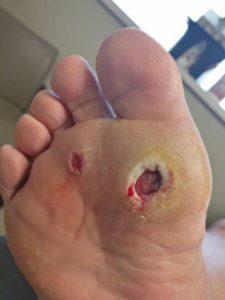
This is where surgery can be especially effective. Reducing the high arch and combining it with good shoes and orthotics can relieve a significant amount of pressure.
How to make a wound heal faster?
- Studies showed that seeing a foot-in-wound specialist such as a podiatrist is one of the single most effective things you can do. Don’t worry.
- The single best thing you can do is evaluate and make sure that you are doing nothing wrong. For example, I mean that some people are usually missing one essential criterion that is necessary to healing.
- This means looking out for the basics.
- The four basics are evaluating your blood flow to make sure you have excellent blood flow, making sure your blood sugar is low and under control, making sure that you are not putting any pressure on your foot, and finally making sure that you don’t have an infection.
- The single biggest mistake in treating foot ulcers is relying on products.
- The biggest waste of time is focusing only on expensive products such as stem cells or expensive creams.
- Sure they are helpful in a comprehensive treatment plan, but we see tons of people doing everything wrong, but then trying to apply an expensive cream and hoping for magical results.
- The true way to heal a diabetic foot ulcer is to make sure you have the four basics in place.
- If you can do these four things well, you are almost guaranteed to heal your wound, but easier said than done!
- Don’t fall into the commercialized trap of buying better and more expensive products and not doing the cheap, easy, and proven basics to be affected by hard science.
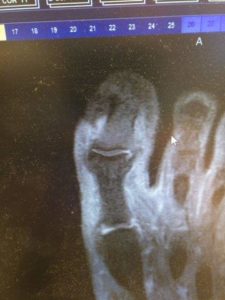
How to treat a diabetic foot ulcer:
The four basics:
Great blood flow:
- See your podiatrist get your blood flow evaluating. This is called your arterial brachial index. This is an easy screening test that can be performed and is usually the first test order.
- Your podiatrist will check your blood flow to your dorsalis pedis and your posterior tibialis arteries. If your blood flow is reasonable, this is the single biggest criterion in your foot ulcer. If you have some blockage, if you are a smoker, if you are a long-term diabetic, your podiatrist will work with a vascular surgeon to optimize your blood flow.
- This is a crucial and essential step. In our opinion, this is the single biggest thing that can be done for most patients with chronic nonhealing ulcers.
Get your diabetes under control:
- This is another area where your podiatrist and primary care doctor can work together in terms of optimizing your healing rate. We often have patients with ulcers, and saying all my blood sugar is normal at 200, this is not normal! If your blood sugar is anything over 120 on average, this will severely compromise your healing ability.
- It is 100% necessary to get your blood sugar as normal as possible to have any chance of healing your ulcer. Don’t fall for the gimmicks. Care products will not work if you do not have blood flow and blood sugar averages over 120. These are the single biggest and easiest things you can do to correct the underlying reasons for why you have an ulcer.
Make sure you don’t have an infection:
- This is an area where your podiatrist can work with an infectious disease doctor. If you have any redness around your wound or drainage from the center of your wound, you likely have an infection of the current. In the short term, it is essential to start taking antibiotics and to get antibiotic medication onto this site. This can be life-threatening if allowed to continue for lengthy periods of time without improving.
- If you have redness or drainage developing around your ulcer, don’t waste any time, this is the single most urgent thing you can do, don’t be someone who loses their leg because they waited one or two days too long.
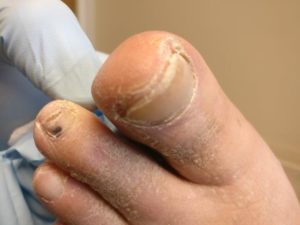
Take the pressure off the diabetic foot ulcer:
- Once you meet the first three criteria for wound healing, this is where podiatrists will really get you to close up your wound as quickly as possible. If you have great blood flow if your diabetes is well-controlled, and if you don’t have an infection, the next best thing is to take pressure off the wound site.
- Once you meet all four of these criteria, the wound rapidly can close for you. That may sound simple when I write it like this, but harder said than done! Most people with foot ulcers have had a hard time staying off of it and are not in the world’s best physical condition. For example, you can’t just hop around 1 foot for a month or two until the wound heals, and it’s usually not an option to just lay in bed for a month or two.
- This is where special equipment like offloading orthotics, good shoe gear, ankle-foot braces, diabetic shoes, and diabetic inserts. Once you’re able to offload the level, most of our patients have pretty rapid healing. In our clinic, patients a day with rooms on their feet, and if we get their feet offloaded and meet the four criteria, I outlined, almost every patient reaches rapid.
Diabetes Foot Ulcer Treatment & Tips
Do you have diabetes & diabetic foot pain? We go over the BEST Diabetic Foot Treatment: Manage Diabetic Foot Symptoms & Prevent Diabetic Foot Ulcers!
0:00 Diabetic Foot Treatment
0:46 Diabetic Foot Podiatrist
1:00 Diabetic Foot Symptoms
1:15 Diabetic Foot Exam
1:35 Diabetic Foot Soaks
2:00 How to soak diabetic feet
2:25 Diabetic foot self assessment at home
2:40 Diabetic Foot Infection
2:55 Diabetic foot socks
3:18 Diabetic foot shoes
3:50 Best Diabetic slippers
4:10 Best Diabetic Shoes
4:35 How to fit a diabetic shoe
4:50 Diabetic foot orthotics
5:05 Diabetes and poor blow flow
5:50 Diabetic foot nerve pain
6:21 Diabetic Foot Peripheral Neuropathy
6:35 Diabetic foot ulcer prevention
6:50 Diabetic foot home remedies and home diabetic foot prevention
Podiatrist & Foot Doctor Treatment
- Toenail Fungus Treatment (Oral or Laser)
- Toenail Trimming.
- Orthotics Fitting.
- Ingrown Toenails.
- Infected Ingrown Toenails.
- Podiatrist pedicure or medical pedicure.
- Trimming of Corns, Trimming of Calluses, and Treatment of Pressure Blisters.
- Diabetic Foot Care & Diabetic Foot Wounds.
- Athletes Foot, Dry Skin, Eczema.
- Foot & Ankle Ulcer Care.
- Infection and Abscess Care.
- Staph Infections in the Toe or Foot Treatment.
- Treatment of Plantar Warts for Your Toes and Feet.
- Foot & Ankle Injections (Steroid or Natural Solutions.)
- Management of Foot & Ankle Fractures (Walking Boots for broken toes or broken feet).
- Heel Pain (Heel Spur or Plantar Fasciitis).
- Custom Orthotics for children and adults (In the office).
- Over the Counter Orthotics for children and adults.
- Podiatrist medical pedicure.
- Extra-Depth Shoes for Patients with Diabetes.
- Diabetic Shoes.
- Gout Treatment.
- Prescription (Refills).
- Telehealth appointments.
- Shockwave therapy (AKA ESWT or EPAT therapy)
- Cold laser therapy (In the office).
- MLS laser therapy (Multi-Wave Locked System laser therapy).
- Laser for peripheral neuropathy (In-Office).
- Senior Toenail Cutting & Toenail Trimming Services.
Top-Rated Products Recommended for Diabetes Foot Ulcer Treatment
Trusted Solutions To Soothe, Protect, and Support Your Feet
Finding the best products for managing peripheral neuropathy and diabetic foot pain can make a world of difference in your daily comfort and mobility.
When it comes to managing foot pain from conditions like plantar fasciitis, flat feet, or diabetic neuropathy, the best orthotics can offer crucial support and relief.
Choosing the best shoes for foot conditions like neuropathy, plantar fasciitis, or flat feet is essential for pain relief and long-term foot health.
Walk This Way: Trusted Foot & Ankle Information
Learn what’s hurting and how to fix it.
Why Choose Balance Foot & Ankle Specialist in Howell and Bloomfield Hills?
Our experienced podiatric surgeons combine precision, care, and innovation to deliver successful outcomes in flatfoot reconstruction. With modern facilities, patient education, and compassionate care, we’ve become the trusted choice for foot and ankle surgery in Southeast Michigan. We’re committed to restoring your stride—comfortably and confidently.
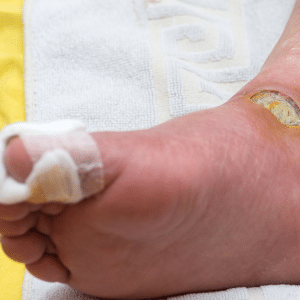
FAQ: Diabetes Foot Ulcer Treatment – Prevention, Care & Recovery
Diabetic foot treatment is specialized care for wounds, infections, nerve damage, and circulation issues caused by diabetes, aimed at preventing serious complications like ulcers or amputations.
People with diabetes are at higher risk for foot problems due to nerve damage (neuropathy) and poor circulation, which can make even small injuries turn serious quickly.
Common issues include ulcers, infections, calluses, corns, fungal nails, cracked skin, and reduced sensation in the feet.
Most patients benefit from a foot exam every 2–3 months, but those with active problems or ulcers should see a podiatrist more frequently.
We provide wound care, pressure offloading, nail and callus care, infection management, circulation testing, diabetic footwear, and patient education.
Yes. Daily self-checks, proper foot hygiene, wearing supportive shoes, and controlling blood sugar levels can greatly reduce your risk.
Seek immediate attention if you notice an open sore, signs of infection (redness, swelling, pus, foul odor), sudden pain, or color changes in the skin.
Yes. We provide custom diabetic shoes and insoles to relieve pressure points, improve stability, and protect your feet from injury.
